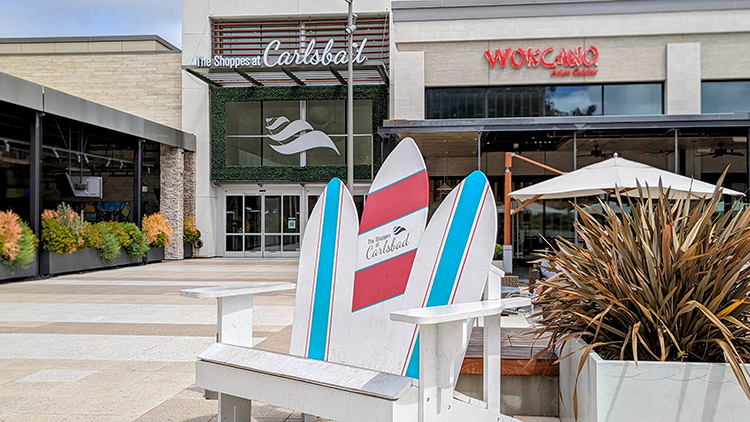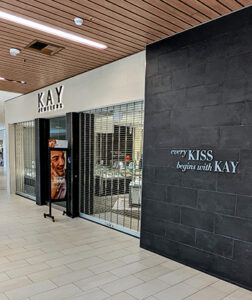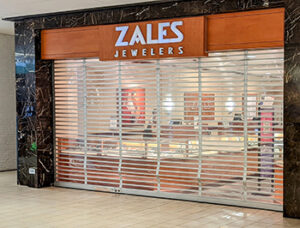 Editor’s Note: This is the 23rd chapter in Volume 3 of Publisher and Editor Donald H. Harrison’s 2022 trilogy, “Schlepping and Schmoozing Along the Interstate 5.” All three books as well as others written by Harrison may be purchased from Amazon.com.
Editor’s Note: This is the 23rd chapter in Volume 3 of Publisher and Editor Donald H. Harrison’s 2022 trilogy, “Schlepping and Schmoozing Along the Interstate 5.” All three books as well as others written by Harrison may be purchased from Amazon.com.
Schlepping and Schmoozing Along the Interstate 5, Volume 3, Exit 51A (Las Flores Drive): Shoppes at Carlsbad
From northbound Interstate 5, take the Las Flores Drive exit and turn left, then make a right turn on Jefferson Street and follow it as it curves northeast to Marron Road. Turn right and park in the lot for the Shoppes at Carlsbad. Zales and Kay Jewelers are both within the mall at 2525 El Camino Real, Carlsbad.

 CARLSBAD, California – At the Shoppes at Carlsbad, Kay Jewelers is located on one floor and Zales on another – a physical manifestation of multilevel marketing. Both are owned by Signet Jewelers which changed its name from Ratners after its CEO, Gerald Ratner, made an unfortunate speech that gave rise to the expression, “Doing a Ratner.”
CARLSBAD, California – At the Shoppes at Carlsbad, Kay Jewelers is located on one floor and Zales on another – a physical manifestation of multilevel marketing. Both are owned by Signet Jewelers which changed its name from Ratners after its CEO, Gerald Ratner, made an unfortunate speech that gave rise to the expression, “Doing a Ratner.”
That expression is not at all complimentary. In business circles, particularly in Britain where Gerald Irving Ratner made and lost a jewelry fortune, it refers to sabotaging one’s own company with ill-thought public remarks.
At the time, Ratner was the chief executive officer of Ratners Group, which owned Kays in the United States as well as such European jewelry houses as H. Samuel, Ernest Jones, Leslie Davis, and Watches of Switzerland. As a boy, his fondness for gambling saw him cutting school and spending his time in betting shops, eventually causing him in 1964 at the age of 15 to be expelled from Hendon County Grammar School. His distraught parents, Leslie and Rachelle, decided that Gerald should be put to work in London in the Oxford Circus branch of the family’s 25-store chain of jewelry shops called Ratners.
Ratner learned his father’s business from the bottom up. He cleaned the surfaces of jewelry display cases, and, during his teenage years, served as what jokingly described as a “gopher” – “Go for this, Go for that!”
Ratner had a competitive streak in him. As his father’s business grew from 25 shops to 130 over the next 20 years, Ratner saw such Jewish contemporaries as Charles Saatchi and Michael Green make amazing strides in business. Saatchi and his brother Maurice opened the Saatchi and Saatchi advertising agency, which became the largest in the world with 600 offices around the globe. Green became the leader of Carlton Communications, which made corporate and rock music videos and television commercials. Eventually Carlton acquired the Moving Picture Company (MPC), which at the time was Europe’s largest provider of video facilities.
While growing up with such contemporaries, Ratner reminisced, “Everybody around me was Jewish. In those days, there was no such thing as a non-Jewish friend.” As a youth, he attended synagogue on High Holy Days. “As I get older,” he said in a 2007 article in The Jewish Chronicle, “I realize how important being Jewish is to me. I have a compatibility with Jews, an affinity and a relaxed feeling that I don’t necessarily have with non-Jews. If anything, I’m getting more religious as I get older, but I only go to synagogue—in Maidenhead—about twice a year.”
While his father’s business was expanding it was to Ratner’s thinking too conservative and too tepid. He once told The Sunday Times that he had observed in East London’s Petticoat Lane Market that among the thousand stall owners on Wentworth Street and its surrounding avenues, the “people who shouted the loudest and appeared to give the best offers sold the most.”

In 1983, his father suffered from the effects of a brain tumor. Leslie Ratner’s behavior changed dramatically. In The Jewish Chronicle, Gerald was quoted as saying that before the tumor became apparent, his father “was very patient, understanding and kind. Afterwards, he didn’t have a fear of anything. In fact, he didn’t seem to have a lot of feelings generally. If a bomb went off outside his house, he wouldn’t have flinched.” It was decided that Gerald, then 34, should assume control of the business.
Although it had expanded, the Ratners chain was steadily losing money and seemed ripe for a takeover. Gerald decided to apply the techniques he had observed at Petticoat Lane Market. He filled his store windows and the sidewalks around them with bright orange advertisements announcing various sales. One oft-printed photograph of one of his stores showed it festooned with advertising banners. “Last Chance 9 Days Left” read one. “Half Price Gold” read another. “Sale: Tax Free Shopping for Overseas Visitors” proclaimed an advertising sawhorse placed on the sidewalk in front of the shop.
Whereas his father had disdained such advertising, sniffing that it cheapened and demeaned the jewelry business, the working-class public was decidedly enthusiastic about the bargains now available to them. Ratner reflected to the Financial Times that to further appeal to the working class he sold earrings, bracelets and rings for an average of £20 compared to the average price of £300 for jewelry at higher-end stores. “I put the earrings and chains in the front of the window and diamond rings at the back and played pop music,” he reminisced.
In seven years, Ratners grew to approximately 2,500 outlets, amazingly capturing more than 50 percent of the jewelry market in the United Kingdom. In 1990, the company reported a profit of £125 million. In the process, the company had purchased such competing jewelry chains as Kay Jewelers.

Kay Jewelers had been founded in 1916 by brothers Edmund and Sol Kaufmann in a corner of their father’s furniture store in Reading, Pennsylvania. Edmund was active in Jewish affairs, serving from 1940-41 as president of the Zionist Organization of America. A Friend of Dr. Chaim Weizmann, who was the first President of Israel, Kaufmann later served as president of the American Committee for the Weizmann Institute of Science. Additionally, Kaufmann was friends with the Reform Judaism leader, Rabbi Stephen S. Wise and with U.S. Supreme Court Justice Louis D. Brandeis, according to a 1950 obituary published by the Jewish Telegraphic Agency.
The success of Ratners earned Gerald an invitation to speak to 6,000 business leaders and journalists at the prestigious Institute of Directors (IoD) on April 23, 1991, at Royal Albert Hall. The Institute had been founded in 1903 to promote “free enterprise, entrepreneurism, wealth creation, and good corporate governance.” An important mission of the Institute was to represent “the views of business and IoD members in the media and with government. As one might imagine, there was considerable interest in what Ratner might say.
He decided to discuss his company’s multilevel marketing approach, explaining that through its various divisions it could offer jewelry for low to high-income purchasers. In discussing lower-end products, such as those for sale at Ratners, he commented: “We also do cut-glass sherry decanters complete with six glasses on a silver-plate tray that your butler can serve you drinks on, all for £4.95. People say ‘How can you sell this for such a low price? I say, ‘because it’s total crap.’” Additionally, he said, Ratners sold a set of earrings “cheaper than a prawn sandwich from Marks & Spencer’s, but I have to say the sandwich will probably last longer than the earrings.”
Ratner had intended the remarks as self-deprecatory humor, but after the Daily Mirror printed the story under the headline, “You 22-carat mugs,” it seemed that Ratner was denigrating his customers as know-nothing, low-class consumers. A 2021 story on the Business Cobra website remembered various headlines as being to the effect of “Jewelry CEO Calls His Own Products ‘Crap’” and that the Sunday Times went so far as to dub him “Gerald Crapner.”
Of course, Ratners tried to walk back the remark and explain that they were intended to be humorous, but the public wasn’t buying it, nor Ratners’ jewelry. Some customers even demanded their money back. The value of the company’s stock dropped £500 in a matter of days losing 80 percent of its value by the end of 1991, according to the Hustle website. Obviously, he was a liability, so Ratner was fired as CEO in 1992. He sold his stock holdings to pay off debts, plummeting from a very wealthy man with expensive cars, houses, and high-society friends to an impoverished “has been.”
In speeches and in his memoir, The Rise and Fall … and Rise Again, Ratner told of the consequences of his ill-thought remarks. “I lost all my money, every single penny because the shares went to 2p. I lost my (large) house, my children had to come out of school. I paid a very big price for that joke. I was in deep, dire difficulties. I was watching Count Down (a program delineating top pop music hits) in bed for seven years. I had given up. I read I was unemployable. I was suffering from depression.”

After nearly seven years of his self-pity, Ratner’s second wife, Moira, had enough. Get out of the house and do something or she would leave him, she said. He borrowed £155,000 on a smaller home to which his family had relocated and started a health club in Henley, Oxfordshire , in 1997. Getting the loan was not easy. “I was a pariah,” he recollected in The Jewish Chronicle article. “I went to countless banks and they all refused me money. They said no one would join my health club. In 2001, sold it for £3.9 million.”
Banks wouldn’t give him a loan so with half the proceeds from the health club sale, Ratner started a new jewelry business, Gerald Online, in which he partnered with the Mumbai, India-based SB&T International to sell jewelry via the Internet. Founded in 2003, the company ceased business in 2014.
Ratners, meanwhile, decided to change its name to Signet Jewelers and mov its domicile from Britain to Bermuda and its headquarters to Akron, Ohio. In addition to Kay, its subsidiaries include Jared, Zales, and JamesAllen.com. In 2012, it acquired ULTRA Diamonds, and converted those stores to Kay outlets. Two years later it purchased Zale Corporation for $21 a share in a $1.4 billion transaction. The merger brought the value of Signet to $6.2 billion. Wikipedia reports the company operated nearly 3,000 stores under different brands in the U.S., United Kingdom, Republic of Ireland, and the Channel Islands.
*
Donald H. Harrison is publisher and editor of San Diego Jewish World. He may be contacted via sdheritage@cox.net